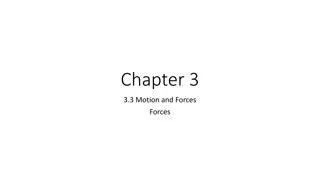Comprehensive Analysis of Porter's Five Forces Framework
Porter's Five Forces framework, developed by Michael Porter, is a strategic tool used to analyze competitive forces within an industry. The model considers factors like the threat of new entrants, bargaining power of suppliers, bargaining power of buyers, threat of substitute products, and intensity of rivalry among existing competitors. Understanding these forces helps businesses assess their competitive position and develop effective strategies to strengthen their market position.
Download Presentation

Please find below an Image/Link to download the presentation.
The content on the website is provided AS IS for your information and personal use only. It may not be sold, licensed, or shared on other websites without obtaining consent from the author.If you encounter any issues during the download, it is possible that the publisher has removed the file from their server.
You are allowed to download the files provided on this website for personal or commercial use, subject to the condition that they are used lawfully. All files are the property of their respective owners.
The content on the website is provided AS IS for your information and personal use only. It may not be sold, licensed, or shared on other websites without obtaining consent from the author.
E N D
Presentation Transcript
Porters Five Forces Michael Porter
Porters Five Forces Threat of Potential Competit ors Intensity of Current Competiti on Threat of Substitute Products Market Profitability Bargainin g Power of Customers Bargainin g Power of Suppliers
Threat of New Entrants Economies of Scale Product Differentiation Threat of Potential Competit ors Capital Requirements Access to Distribution Channels Government Policy
Porters Five Forces Threat of Potential Competit ors Intensity of Current Competiti on Threat of Substitute Products Market Profitability Bargainin g Power of Customers Bargainin g Power of Suppliers
Bargaining Power of Suppliers Suppliers are likely to be powerful if: Supplier industry is dominated by a few firms Suppliers products have few substitutes Bargainin g Power of Suppliers Buyer is not an important customer to supplier Suppliers product is an important input to buyers product Suppliers products have high switching costs Supplier poses credible threat of forward integration
Porters Five Forces Threat of Potential Competit ors Intensity of Current Competiti on Threat of Substitute Products Market Profitability Bargainin g Power of Customers Bargainin g Power of Suppliers
Bargaining Power of Buyers Buyer groups are likely to be powerful if: Buyers are concentrated or purchases are large relative to seller s sales Purchase accounts for a significant fraction of supplier s sales Bargainin g Power of Customers Products are undifferentiated Buyers face few switching costs Buyer presents a credible threat of backward integration Product unimportant to quality
Porters Five Forces Threat of Potential Competit ors Intensity of Current Competiti on Threat of Substitute Products Market Profitability Bargainin g Power of Customers Bargainin g Power of Suppliers
Threat of Substitute Products Keys to evaluate substitute products: Products with improving price/performance tradeoffs relative to present industry products Threat of Substitute Products Example: Electronic security systems in place of security guards Fax machines in place of overnight mail delivery
Porters Five Forces Threat of Potential Competit ors Intensity of Current Competiti on Threat of Substitute Products Market Profitability Bargainin g Power of Customers Bargainin g Power of Suppliers
Rivalry Among Existing Competitors Intense rivalry often plays out in the following ways: Using price competition Staging advertising battles Increasing consumer warranties or service Making new product introductions






































